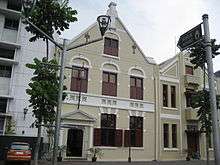Wayang Museum
 | |
| Established | 1975 |
|---|---|
| Location | Pintu Besar Utara Street 27, Jakarta Barat, Jakarta, Indonesia |
| Type | Puppet museum |
| Public transit access |
|
The Wayang Museum (Indonesian: Museum Wayang) is a museum dedicated to Javanese wayang puppetry. The museum is located in Kota Tua, Jakarta, Indonesia. It is one of several museums and galleries facing the Fatahillah Square, which include Jakarta History Museum, Fine Art and Ceramic Museum, and Kota Post Office art gallery.[1]
History

The museum building occupies the site of a church which was built in 1640, under the name of the Old Dutch Church (Dutch: De Oude Hollandsche Kerk).[2] In 1732, the church was renovated and the name was changed into the New Dutch Church (Dutch: De Nieuwe Hollandsche Kerk). In 1808, an earthquake destroyed the church.[3] Later in 1912, a building was constructed in the Neo-Renaissance style on the site, which initially functioned as a warehouse belonging to Geo Wehry & Co. In 1938, the building was renovated, following Dutch colonial architecture. The garden of the Wayang Museum, located on the former yard of the Dutch church, was the funeral site of General Governor Jan Pieterszoon Coen.
Later, the building was bought by the Batavia Society of Arts and Sciences (Dutch: Bataviasche Genootschap van Kunsten en Wetenschappen), an institution dealing with Indonesian culture and science. The institution then transferred this building to the Old Batavia Foundation (Dutch: Stichting Oud Batavia) and on December 22, 1939, it was made a museum under the name of Old Batavia Museum (Dutch: Oude Bataviasche Museum). In 1957, after the independence of Indonesia, the building was transferred to the Institute of Indonesian Culture (Indonesian: Lembaga Kebudayaan Indonesia) and on September 17, 1962, to the Ministry of Education and Culture. On June 23, 1968, the DKI Jakarta Administration made the building into the Wayang Museum; the inauguration took place on August 13, 1975. The museum is also a venue for training and research on shadow puppets.[4]

Collections
The museum has a collection of various kinds of wayang, such as wayang kulit and wayang golek from countries like Malaysia, Thailand, Suriname, China, Vietnam, France, India and Cambodia. The museum also shows gamelan sets, wayang sculptures, as well as wayang paintings.[4] Inside the museum is the plate marking the tombstone of Jan Pieterszoon Coen.[3] A wayang theater and a workshop of wayang-making are periodically organised in the museum.
References
- ↑ Kuoni - Far East, A world of difference. Page 93. Published 1999 by Kuoni Travel & JPM Publications
- ↑ Suswantoro, Ani, "Wayang Museum: Of heroes and grand tales", The Jakarta Postl, June 27, 2014
- 1 2 3 "Museum Wayang in Jakarta". asiarooms.com. 2010. Retrieved January 7, 2010.
- 1 2 "Shadow Puppets Museum". Indonesia Tourism. IndonesiaWebPromotion. Retrieved 2009-12-29.
External links
![]() Media related to Wayang Museum at Wikimedia Commons
Coordinates: 6°08′05″S 106°48′45″E / 6.1347°S 106.8124°E
Media related to Wayang Museum at Wikimedia Commons
Coordinates: 6°08′05″S 106°48′45″E / 6.1347°S 106.8124°E